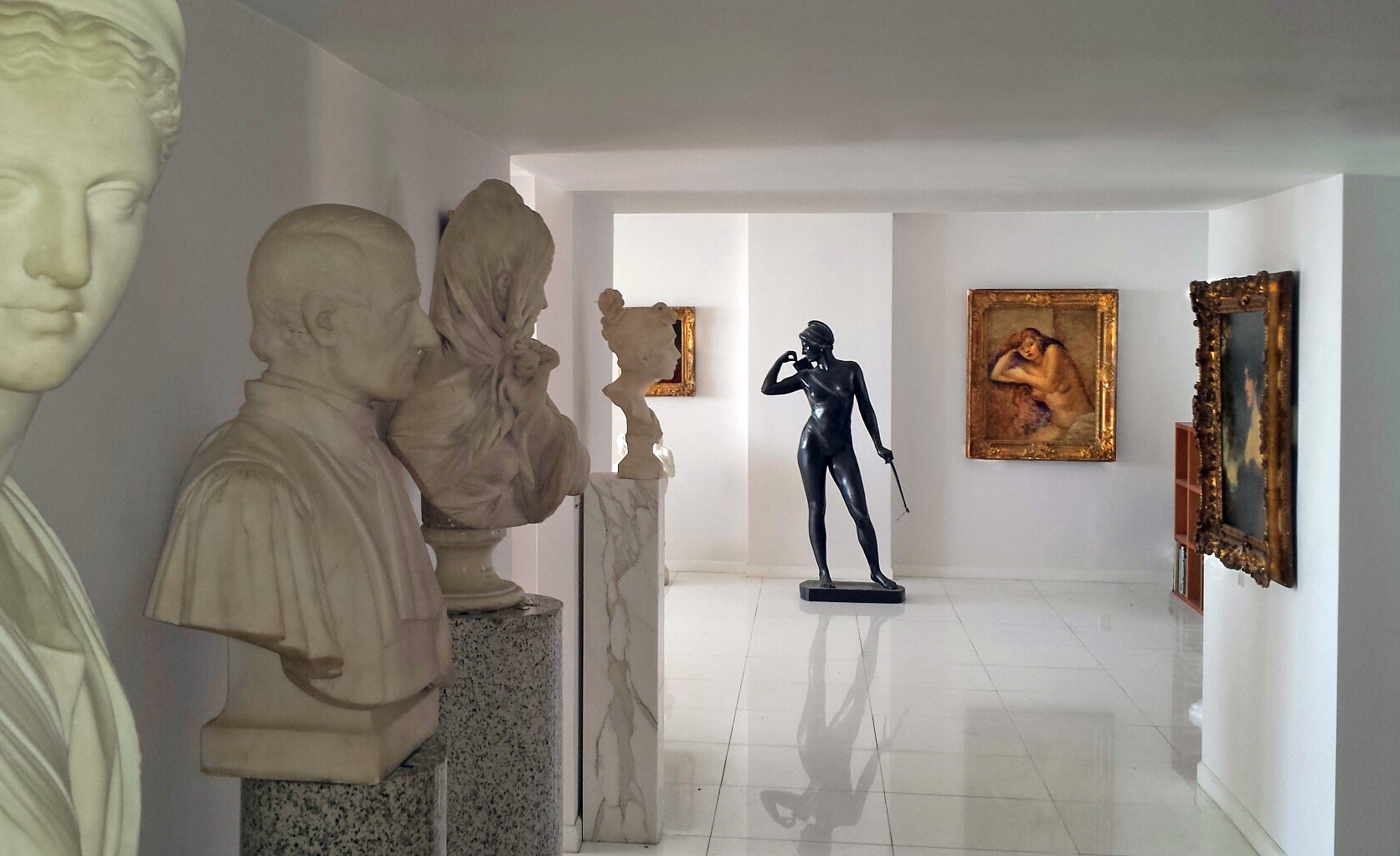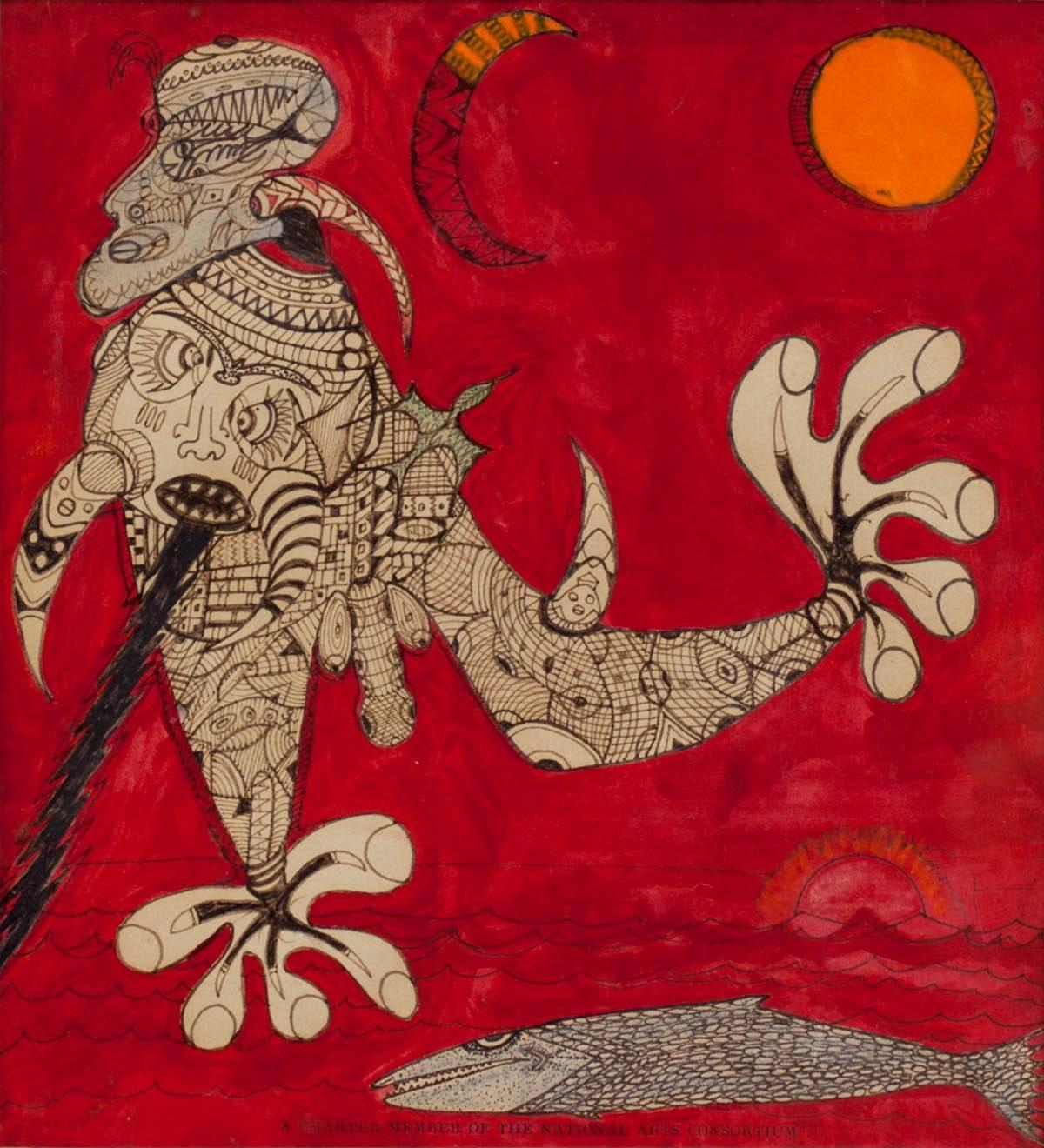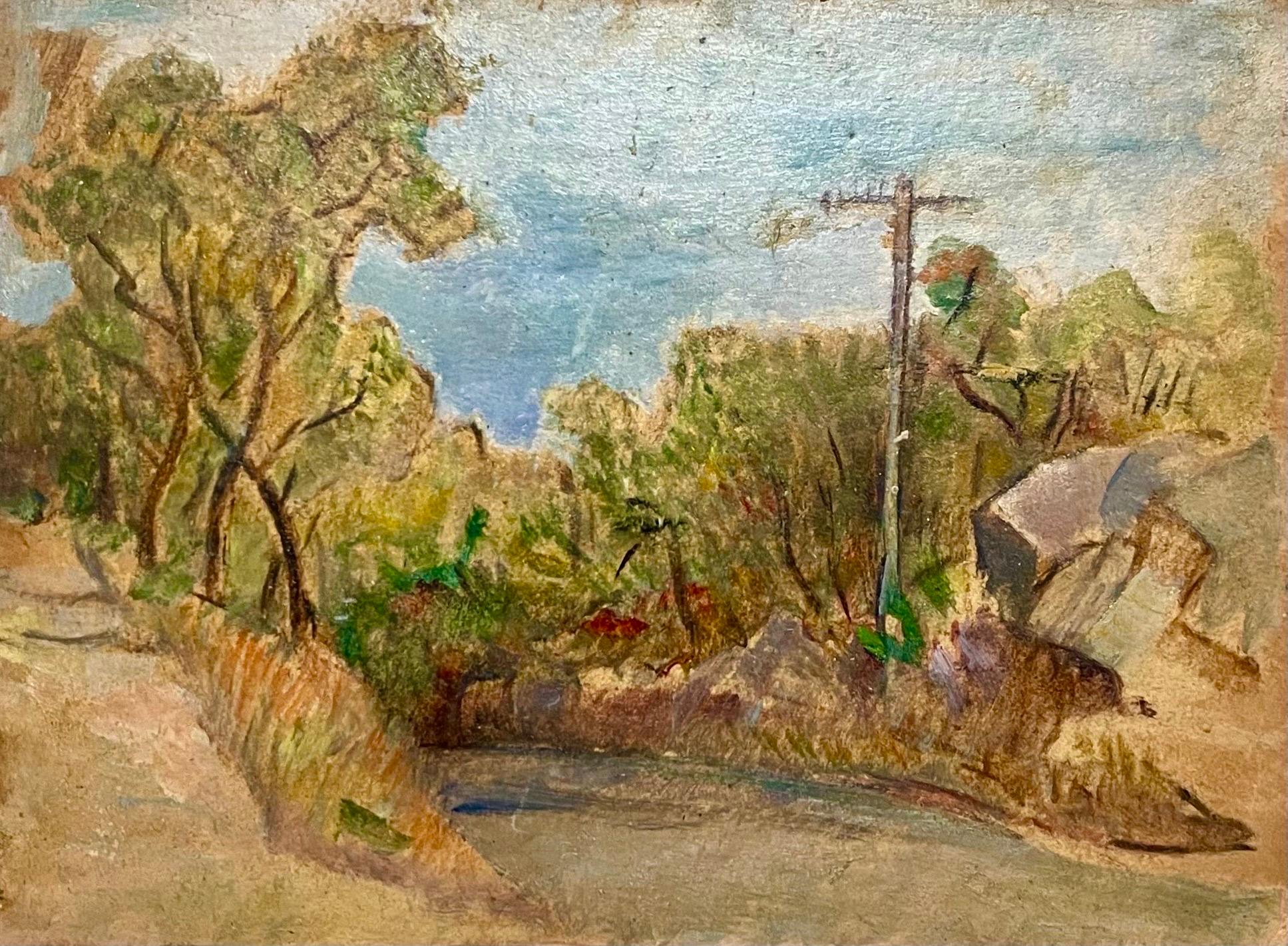Items Similar to Vogue Magazine Cover, Alternate
Want more images or videos?
Request additional images or videos from the seller
1 of 6
Eugene BermanVogue Magazine Cover, Alternate1948
1948
About the Item
Alternative Cover work, Ink, Gouache, Watercolor on paper
Initialed and dated lower center
h: 9.2 x w: 12 in / h: 23.4 x w: 30.5 cm
Worth Avenue Gallery, Palm Beach
Robert L. Tobin Collection , Original Gallery Frame
- Creator:Eugene Berman (1899 - 1972, Russian)
- Creation Year:1948
- Dimensions:Height: 9.2 in (23.37 cm)Width: 12 in (30.48 cm)
- Medium:
- Movement & Style:
- Period:
- Condition:
- Gallery Location:Miami, FL
- Reference Number:1stDibs: LU38531221003

About the Seller
4.9
Gold Seller
These expertly vetted sellers are highly rated and consistently exceed customer expectations.
Established in 2005
1stDibs seller since 2016
102 sales on 1stDibs
Typical response time: 1 hour
- ShippingRetrieving quote...Ships From: Miami, FL
- Return PolicyA return for this item may be initiated within 3 days of delivery.
More From This SellerView All
- Saturday Evening Post Illustration. “ The Devil’s Stronghold” Original MagazineBy Edwin GeorgiLocated in Miami, FLThe work is mostly black and white to indicate that this is a night scene. On closer inspection, you will see areas of magenta and ivory throughout The publisher's label on verso ide...Category
1960s American Modern Portrait Paintings
MaterialsGouache, India Ink, Pencil
- Suzanna and the EldersBy Ben ShahnLocated in Miami, FLA modern interpretation of the biblical story Suzanna and the Elders. Signed lower right Ink and wash on paper The Downtown Gallery Felix Landau Gallery Ernest Brown & Phillips, Ltd...Category
1940s American Modern Portrait Paintings
MaterialsWatercolor, Ink, Gouache, Archival Paper
- "The Glorious Flight - Across the Channel with Louis Bleriot" - Children's BookBy Alice and Martin ProvensenLocated in Miami, FLStudy for "The Glorious Flight - Across the Channel with Louis Bleriot"; 1983; Gouache on Illustration Board; 14.5" x 13.75"; Signed Lower Right; Unframed. From Wikipedia, the free encyclopedia Alice Rose[1] Provensen (née Twitchell; August 14, 1918[2] – April 23, 2018[3]) and Martin Provensen...Category
1980s American Modern Figurative Paintings
MaterialsBoard, Gouache
- Groovy Lucille Ball, original painting for TV Guide coverBy Bob PeakLocated in Miami, FLBob Peak's Lucille Ball, TV guide cover is a seminal work. With its stylized design and use of punchy color, this work constitutes a powerfully innovative pai...Category
1960s American Modern Figurative Paintings
MaterialsMixed Media, Gouache
- Woman Baking, Redbook Illustration, Mid - CenturyBy Lorraine FoxLocated in Miami, FLSigned lower right, unframed - Interior Illustration for Redbook MagazineCategory
1950s American Modern Figurative Paintings
MaterialsGouache
- Protest Revolt and Uprising illustrationBy Daniel MaffiaLocated in Miami, FLThis work is a quintessential protest statement piece depicting an angry mob brandishing powerful fits in the air in gestures of revolt Signed lower right. Daniel Maffia has done a ...Category
1980s American Modern Figurative Paintings
MaterialsMixed Media, Gouache
You May Also Like
- "Three Muses" 1987 Paint & Ink Nude American Modernist Jack HooperBy Jack HooperLocated in Arp, TXJack Hooper "Three Muses" 1987 Gouache and ink on paper 21.25"x15.5" unframed Signed and dated in pencil lower left In this minimalist composition on black paper, Jack Hooper expert...Category
1980s American Modern Mixed Media
MaterialsPaper, Gouache, Ink
- Indian Modernist PaintingLocated in Surfside, FLGod, Keeper, and Maker of all Air Tola-Kina. Figural Abstract Gouache Watercolor Painting.Category
20th Century Modern Figurative Paintings
MaterialsIndia Ink, Watercolor, Gouache
- Simka Simkhovitch WPA Artist Oil Painting Gouache American Modernist PowerlineBy Simka SimkhovitchLocated in Surfside, FLSimka Simkhovitch (Russian/American 1893 - 1949) This came with a small grouping from the artist's family, some were hand signed some were not. These were studies for larger paintings. Simka Simkhovitch (Симха Файбусович Симхович) (aka Simka Faibusovich Simkhovich) (Novozybkov, Russia May 21, 1885 O.S./June 2, 1885 N.S.—Greenwich, Connecticut February 25, 1949) was a Ukrainian-Russian Jewish artist and immigrant to the United States. He painted theater scenery in his early career and then had several showings in galleries in New York City. Winning Works Progress Administration (WPA) commissions in the 1930s, he completed murals for the post offices in Jackson, Mississippi and Beaufort, North Carolina. His works are in the permanent collections of the Dallas Museum of Art, the National Museum of American Art and the Whitney Museum of American Art. Born outside Kyiv (Petrograd Ukraine) into a Jewish family who owned a small department store. During a severe case of measles when he was seven, Simcha Simchovitch sketched the views outside his window and decided to become an artist, over his father's objections. Beginning in 1905, he studied at the Grekov Odessa Art School and upon completion of his studies in 1911 received a recommendation to be admitted to the Imperial Academy of Arts. Though he enrolled to begin classes in architecture, painting, and sculpture at the Imperial Academy, he was dropped from the school roster in December because of the quota on the number of Jewish students and drafted into the army. Simchovitch served as a private in the 175th Infantry Regiment Baturyn [ru] until his demobilization in 1912. Re-enrolling in the Imperial Academy, he audited classes. Simka Simkhovitch exhibited paintings and sculptures in 1918 as part of an exhibition of Jewish artists and in 1919 placed 1st in the competition "The Great Russian Revolution" with a painting called "Russian Revolution" which was hung in the State Museum of Revolution. In 1922, Simkha Simkhovitch exhibited at the International Book Fair in Florence (Italian: Fiera Internazionale del Libro di Firenze). In 1924, Simkhovitch came to the United States to make illustrations for Soviet textbooks and decided to immigrate instead. Initially he supported himself by doing commercial art and a few portrait commissions. In 1927, he was hired to paint a screen for a scene in the play "The Command to Love" by Fritz Gottwald and Rudolph Lothar which was playing at the Longacre Theatre on Broadway. Art dealers began clamoring for the screen and Simkhovitch began a career as a screen painter for the theater. Catching the attention of the screenwriter, Ernest Pascal, he worked as an illustrator for Pascal, who then introduced him to gallery owner, Marie Sterner. Simkhovitch's works appeared at the Marie Sterner Gallery beginning with a 1927 exhibit and were repeated the following year. Simkhovitch had an exhibit in 1929 at Sterner's on circus paintings. In 1931, he held a showing of works at the Helen Hackett Gallery, in New York City and later that same year he was one of the featured artists of a special exhibit in San Francisco at the California Palace of the Legion of Honor in Lincoln Park. The exhibit was coordinated by Marie Sterner and included four watercolors, including one titled "Nudes". He is of the generation of Russian Soviet artists such as Isaac Pailes, Serge Charchoune, Marc Chagall, Chana Orloff, Isaac Ilyich Levitan, and Ossip Zadkine. In 1936, Simkhovitch was selected to complete the mural for the WPA Post office project in Jackson, Mississippi. The mural was hung in the post office and courthouse in 1938 depicted a plantation theme. Painted on the wall behind the judge’s bench, “Pursuits of Life in Mississippi”, a depiction of black workers engaged in manual labor amid scenes of white professionals and socialites, was eventually covered over in later years during renovations due to its stereotypical African American imagery. Simka painted what he thought was typical of Jackson. His impression of pre-civil rights Mississippi was evidently Greek Revival column houses, weeping willow trees, working class families, and the oppression of African Americans. He painted African American men picking cotton, while a white man took account of the harvest and a white judge advised a white family, calling it Pursuits of Life in Mississippi. Though clearly endorsed by the government and initially generally well-received, the mural soon raised concerns with locals as the climate toward racial segregation began to change. The main concern was whether depictions that show African Americans in subjugated societal roles should be featured in a courtroom. The following year, his painting "Holiday" won praise at an exhibition in Lincoln, Nebraska. In 1940, Simkhovitch's second WPA post office project was completed when four murals, "The Cape Lookout Lighthouse and the Orville W. Mail Boat", "The Wreck of the Crissie Wright", "Sand Ponies" and "Canada Geese" were installed in Beaufort, North Carolina. The works were commissioned in 1938 and did not generate the controversy that the Jackson mural had. The main mural is "The Wreck of the Crissie Wright" and depicts a shipwreck which had occurred in Beaufort in 1866. "The Cape Lookout Lighthouse and the Orville W. Mail Boat" depicted the lighthouse built in 1859 and the mail boat that was running mail during the time which Simkhovitch was there. The boat ran mail for the area until 1957. "Sand Ponies" shows the wild horses common to the North Carolina barrier islands and "Canada Geese" showed the importance of hunting and fishing in the area. All four murals were restored in the 1990s by Elisabeth Speight, daughter of two other WPA muralists, Francis Speight...Category
1930s American Modern Landscape Paintings
MaterialsGouache, Oil, Board
- Simka Simkhovitch WPA W/C Painting Gouache American Modernist Beach Scene NudeBy Simka SimkhovitchLocated in Surfside, FLSimka Simkhovitch (Russian/American 1893 - 1949) This came with a small grouping from the artist's family, some were hand signed some were not. These were studies for larger paintings. This is a watercolor and gouache beach scene three young men bathing...Category
1930s American Modern Nude Paintings
MaterialsWatercolor, Gouache, Board
- Portrait of an Old Man with Cane, Important Chicago Modernist WPA ArtistBy William S. SchwartzLocated in Surfside, FLPortrait of an Old Man with Cane, by American artist William S. Schwartz, c. 1940, gouache painting, signed l.l, framed. William S. Schwartz (February 23, 1896 – February 10, 1977) was an American artist who lived and worked in Chicago. Schwartz was born in Smorgon in Belarus, then in the Russian Empire in 1896. His parents were Samuel Schwartz and Tauba Reznikoff. At the age of thirteen, he moved to the nearby city of Vilna to attend art school. Four years later, he emigrated to the United States and eventually enrolled in the School of the Art Institute of Chicago. After graduating, he put his art career on hold to concentrate on a budding career as an opera singer. When Schwartz returned to painting, he distinguished himself with dreamy, symbolist works and abstractions that tended to bewilder viewers. He also scandalized conservative audiences with numerous lithographs of nude women. During the Great Depression, Schwartz became an artist on the Federal Art Project (WPA) payroll painting murals. He was one of the seven WPA artists who contributed to a mural at Riccardo's, Schwartz (Music), Malvin Albright (Sculpture), Ivan Alrbight (Drama), Aaron Bohrod (Architecture), Rudolph Weisenborn (Literature), Vincent D’Agostino (Painting), and Ric Riccardo (Dance). In 2002 Chicago philanthropist Seymour H. Persky acquired the murals for his personal collection. Through the WPA, Schwarz received commissions to produce murals in post offices and public spaces. He created his “Americana Series,” a group of four paintings featuring poets, painters, composers and scientists. His Composersdepicts four contemporary musicians, among them, Victor Herbert. The mural was discovered at Glencoe Public Library, IL, in 2007, and include: Americana No. 1 Poets: Mark Twain, Walt Whitman and Edgar Allen Poe; Americana No. 2 Painters: Saint Gaudens, Bellows, Sargent, Innes, Whistler and Homer; Americana No. 3 Composers: Herbert, DeKoven, Chadwick, MacDowel; Americana No. 4 Scientists: Thomas Alva Edison, Steinmetz, Alexander Graham Bell...Category
Mid-20th Century American Modern Figurative Paintings
MaterialsGouache
- Modernist Judaica Jewish Ink Drawing Painting "New Immigrant" Off the Boat WPABy Ben-Zion WeinmanLocated in Surfside, FLAn ink drawing Judaic painting by modern artist Ben-Zion Weinman. It depicts a portrait of an old Jewish man. Coming over from Europe on a ship crossing. The work is signed "Ben-Zion". Born in 1897, Ben-Zion Weinman celebrated his European Jewish heritage in his visual works as a sculptor, painter, and printmaker. Influenced by Spinoza, Knut Hamsun, and Wladyslaw Reymont, as well as Hebrew literature, Ben-Zion wrote poetry and essays that, like his visual work, attempt to reveal the deep “connection between man and the divine, and between man and earth.” An emigrant from the Ukraine, he came to the US in 1920. He wrote fairy tales and poems in Hebrew under the name Benzion Weinman, but when he began painting he dropped his last name and hyphenated his first, saying an artist needed only one name. In 1920 he settled in America, where he found little interest in his writing. He began teaching Hebrew to support himself and then in the early 1930s returned to painting. He used his art to comment on the rise of fascism in Europe, events he felt could not be adequately explored with words. Largely self-taught, Ben-Zion visited the museums of New York City to learn his new trade. His first painting on a large scale, Friday Evening (1933, Jewish Museum, New York), depicts a Sabbath dinner table as recalled from his family home. Ben-Zion supported himself by working odd jobs until the establishment of the Works Progress Administration's Federal Art Project. Under the auspices of the wpa, Ben-Zion thrived and galleries began to show his work. In 1936, after his first one-man show at the Artists' Gallery in New York Ben-Zion was a founding member of “The Ten: An Independent Group” The Ten” a 1930’s...Category
1940s American Modern Figurative Paintings
MaterialsWatercolor, Gouache





